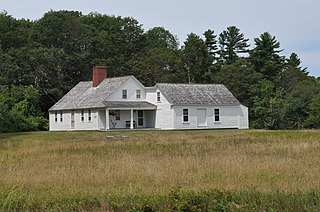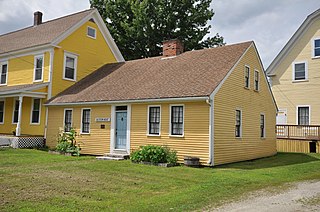
The Benjamin Cleaves House is a historic house on South High Street in Bridgton, Maine, United States. Built in 1828, it is a well-preserved late example of Federal period architecture, and is most notable for the murals drawn on its walls, probably by the itinerant artist Rufus Porter. The house was listed on the National Register of Historic Places in 1988.

The Nickels-Sortwell House is a historic house museum at 121 Main Street in Wiscasset, Maine, United States. Built in 1807 by a wealthy ship's captain, the house was designated a National Historic Landmark in 1970 as an exceptionally high-quality example of the Federal style of architecture. After serving as a hotel for much of the 19th century, the house returned to private hands in 1900. It was given to Historic New England in 1958, which gives tours of the house between May and October.

The William Briggs Homestead is an historic farmhouse at 1470 Turner Street in Auburn, Maine. Built in 1797 by one of the area's early settlers, it is one of Auburn's oldest surviving buildings. It was listed on the National Register of Historic Places in 1986.

The Holman Day House is a historic house at 2 Goff Street in Auburn, Maine. Built in 1895, it is one of the state's finest examples of Queen Anne architecture, and is further notable as the home of Maine author Holman Day. It was listed on the National Register of Historic Places in 1978.
The Ebenezer Knowlton House is a historic house on Choate Road in Montville, Maine. Built c. 1827, the property, which includes two period barns, is a well-preserved example of vernacular late Federal period architecture. The property is also notable as the childhood home of Rev. Ebenezer Knowlton, Jr., a Free Will Baptist minister and a trustee of Bates College in Lewiston, Maine, and Colby College, in Waterville, Maine. The house was added to the National Register of Historic Places in 2002.

The John B. Russwurm House is an historic house at 238 Ocean Avenue in the Back Cove neighborhood of Portland, Maine. Built about 1810, it was the residence of American abolitionist and Liberian colonist John Brown Russwurm. The house was listed on the National Register of Historic Places in 1983.

The Tarr–Eaton House, also known as Tarr–Eaton–Hackett House, is an historic house at 906 Harpswell Neck Road in Harpswell, Maine. Built before 1783 and enlarged about 1840, it is a well-preserved 18th-century Cape with added Greek Revival features, and one of Harpswell's few surviving pre-Revolutionary War buildings. It was listed on the National Register of Historic Places in 2001.

The Nathan Harris House is an historic house at 425 Main Street in Westbrook, Maine. Built about 1830, it is a well-preserved example of Federal period architecture, most notable for the murals painted on some of its walls in the 1830s. It was listed on the National Register of Historic Places in 1993. The house is now used as a professional office.

Columbia House, also known as Gowen Wilson Tavern, is a historic house and hotel on Main Street in Columbia Falls, Maine. Probably built about 1834, it was for many years the town's only hotel, apparently closing about 1882. It is a locally important example of transitional Federal-Greek Revival architecture, and was listed on the National Register of Historic Places in 2000.
The Brown-Pilsbury Double House is a historic two-family house at 188–190 Franklin Street in Bucksport, Maine, United States. Built c. 1808, it is an architecturally distinctive and regionally rare example of an early 19th-century wood frame duplex. It was listed on the National Register of Historic Places in 1997.

The Grant Family House is a historic house at 72 Grant Street in Saco, Maine. Built in 1825, the house is a fine local example of Federal period architecture, but is most notable for an extensive series of well-preserved stenciled artwork on the walls of its hall and main parlor. The house was listed on the National Register of Historic Places in 1990.

The Thacher-Goodale House is a historic house at 121 North Street in Saco, Maine. Built in 1827, it is a sophisticated early expression of Greek Revival architecture, retaining significant Federal period details. Built for George Thacher, Jr., a lawyer, it was owned for many years by members of the Goodale family, most notably the botanist George Lincoln Goodale. The house was listed on the National Register of Historic Places in 1976.

The Holmes Cottage is a historic house at 521 Main Street in Calais, Maine. Estimated to have been built about 1820, it is the oldest surviving structure in the town, and is notable for its association with Dr. Job Holmes, a leading physician during the community's formative years. The cottage, now owned by the St. Croix Historical Society and operated by them as the Dr. Job Holmes Cottage & Museum, was listed on the National Register of Historic Places in 1988.

The Cushing and Hannah Prince House is a historic house at 189 Greely Road in Yarmouth, Maine. Built in 1785 and substantially remodeled about 1830, it is a fine local example of a rural Federal period farmhouse with Greek Revival features. It was listed on the National Register of Historic Places in 1999.

The Heal Family House, also known as the Washington Heal House, is a historic house on Maine State Route 127 in Georgetown, Maine. Built about 1798, it is one of a small number of surviving Federal period houses in the rural community. It was owned for more than 100 years by members of the Heal family. It was listed on the National Register of Historic Places in 1994.

The Blossom House is a historic house museum on Main Street in Monmouth, Maine. Built about 1808, it is a well-preserved example of a Federal period Cape style house. It was listed on the National Register of Historic Places in 1989, and now serves as a museum for the local historical society.

The Dutton-Small House is a historic house on Bog Road in Vassalboro, Maine. Built about 1825, it is one of the rural community's oldest buildings, and one of its only brick houses. It was listed on the National Register of Historic Places in 1990.
The Squire Tarbox House is a historic house at 1181 Main Road in Westport, Maine. Built in 1763 and enlarged in 1820, it is a fine local example of Georgian and Federal architecture. It was listed on the National Register of Historic Places in 1985, and is presently home to the Squire Tarbox Inn.

The Fowler-Steele House, also known historically as Ivy Hall, is a historic house on North Main Street in Windsor, Vermont, United States. Built in 1805 and restyled about 1850, it has an architecturally distinctive blend of Federal and Greek Revival styles. It served for many years as a local church parsonage. It was listed on the National Register of Historic Places in 1982.

The Houghton House is a historic house at 86 South Main Street in the city of St. Albans, Vermont. Built about 1800, with an interior dating to 1829–30, it is a fine and little-altered local example of transitional Georgian-Federal styling, and is one of the city's oldest surviving buildings. It was listed on the National Register of Historic Places in 1972. It presently houses a funeral home.



















